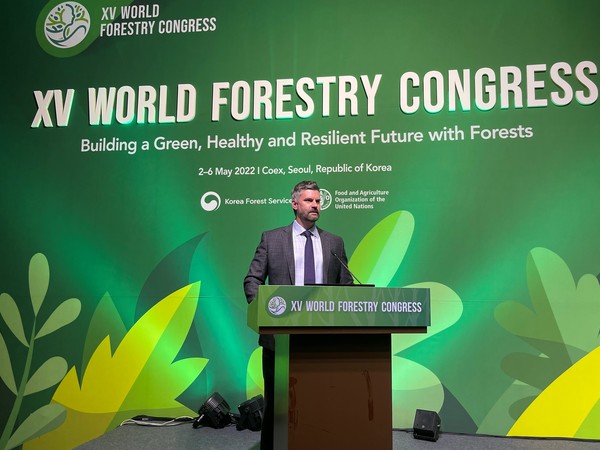
FPAC responds to new report slamming Canada’s logging emissions
September 6, 2024
By Canadian Biomass staff
 Derek Nighbor, FPAC president Photo: Submitted
Derek Nighbor, FPAC president Photo: Submitted The Forest Products Association of Canada has responded to a recent report slamming Canada’s logging sector as the country’s third highest carbon emitter, behind oil and gas and transportation.
The report, released by environmental groups including Nature Canada, criticizes the government’s carbon reporting for the sector saying it fuels “the mischaracterization of logging as carbon neutral or even a carbon sink.”
It found that the logging industry in Canada emitted almost 150 million tonnes of carbon dioxide in 2022, more than 20% of Canada’s total reported emissions.
FPAC said the government’s approach to forest carbon reporting “continues to be based on science and evidence” and the country needs to “scale-up” proactive forest management to mitigate wildfire risk — a massive contributor to emissions.
The full statement is below:
“The Canadian government’s approach to forest carbon reporting and accounting continues to be based on science and evidence. The approach is consistent with the guidelines of the United Nations Framework Convention on Climate Change (UNFCCC) and the Intergovernmental Panel on Climate Change (IPCC).
Worsening fire patterns are drastically changing Canada’s carbon story – and putting people’s lives, critical infrastructure, air quality, and the health and resiliency of our forests at risk. Working together to mitigate these future fire risks needs to be a top national priority for all of us.
Our most recent wildfire season and the devastation we saw in the Town of Jasper and Jasper National Park are clear reminders that Canada needs to scale-up proactive measures, to help reduce the risk of wildfire. Forest management is a critical tool to help us achieve this – along with fire shed mapping, creating more fire breaks, and turning more to thinning treatments and prescribed and cultural burning.
Our sector and its workers have an important role to play to help reduce fire risks and related emissions not only through active forest management and forest renewal, but also by making wood-based products and bioenergy to help lower the carbon footprints of our homes, businesses, towns, and cities.
Leading forested nations with ambitious decarbonization plans like Finland and Sweden have long recognized that wood and wood-based products are a key part of the game plan to lower carbon emissions.
To learn more about how Canada’s forest sector and workers can support forest resilience and mitigate worsening fires and carbon emissions, please visit; How Canada’s Forest Sector Can Support Wildfire Resilience.
To learn more about how the Canada can become a leader in Climate-Smart Forestry (CSF), please visit: Climate-Smart Forestry for a Sustainable Environment, Economy, and Communities.
To learn more about how the sector can help reduce emissions nationally along the forestry value chain, please visit: Climate Change Mitigation in Canada’s Forest Products Sector: Roadmap Toward Net-Zero.
This work is important and its complex. It will require a whole of society approach that includes Canadian forestry workers and active forest management as part of the solution for both the environment and our economy.”
FPAC provides a voice for Canada’s wood, pulp, paper, and wood-based bioproducts producers nationally and internationally in government, trade, and environmental affairs. As an industry with annual revenues exceeding $97B, Canada’s forest products sector is one of the country’s largest employers operating in hundreds of communities, providing 200,000 direct jobs, and over 370,000 indirect jobs across the country. Our members are committed to collaborating with Indigenous leaders, government bodies, and other key stakeholders to develop a cross-Canada action plan aimed at advancing forest health, while supporting workers, communities, and our environment for the long term.
Print this page
- FutureMetrics: Biomass conversion low cost solution when decarbonizing on-demand power
- North America’s biggest names in forestry heading DEMO International in Venosta, Que.